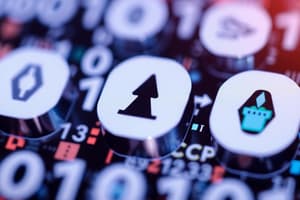Podcast
Questions and Answers
What is a notable advantage of analog signals over digital signals?
What is a notable advantage of analog signals over digital signals?
- Higher security levels for sensitive data
- Direct representation of a physical quantity (correct)
- Easier processing and storage capabilities
- Higher resistance to noise and degradation
Which of the following is a common application for digital signals?
Which of the following is a common application for digital signals?
- Mobile phones (correct)
- Audio recording
- Scientific instruments like thermometers
- Weather monitoring
What is a disadvantage of digital signals compared to analog signals?
What is a disadvantage of digital signals compared to analog signals?
- Difficult to process computationally
- More susceptible to noise during transmission
- Limited accuracy due to discretization (correct)
- Inability to represent continuous data
Which characteristic of analog signals makes them prone to issues during transmission?
Which characteristic of analog signals makes them prone to issues during transmission?
What may occur during the conversion from analog to digital signals?
What may occur during the conversion from analog to digital signals?
Which of the following is a characteristic of analog data?
Which of the following is a characteristic of analog data?
What is a primary advantage of digital data over analog data?
What is a primary advantage of digital data over analog data?
Which of the following best describes analog-to-digital conversion (ADC)?
Which of the following best describes analog-to-digital conversion (ADC)?
How does noise affect analog signals compared to digital signals?
How does noise affect analog signals compared to digital signals?
Which of the following statements is true regarding the storage of analog and digital data?
Which of the following statements is true regarding the storage of analog and digital data?
What is often a challenge when processing analog signals?
What is often a challenge when processing analog signals?
Which of the following best describes digital data?
Which of the following best describes digital data?
What is the process of converting digital signals back to analog signals called?
What is the process of converting digital signals back to analog signals called?
Flashcards
Analog-to-Digital Conversion (ADC)
Analog-to-Digital Conversion (ADC)
The process of transforming an analog signal into a digital representation.
Digital-to-Analog Conversion (DAC)
Digital-to-Analog Conversion (DAC)
The process of transforming a digital signal back into its original analog form. This is often called decoding.
Conversion Error
Conversion Error
The difference between an analog signal and its digital representation. It can be caused by factors like quantization noise.
Analog Signal
Analog Signal
Signup and view all the flashcards
Digital Signal
Digital Signal
Signup and view all the flashcards
What is Analog Data?
What is Analog Data?
Signup and view all the flashcards
What is Digital Data?
What is Digital Data?
Signup and view all the flashcards
How does Analog Data differ from Digital Data?
How does Analog Data differ from Digital Data?
Signup and view all the flashcards
How does Digital Data differ from Analog Data?
How does Digital Data differ from Analog Data?
Signup and view all the flashcards
What is Analog-to-Digital Conversion (ADC)?
What is Analog-to-Digital Conversion (ADC)?
Signup and view all the flashcards
What is Digital-to-Analog Conversion (DAC)?
What is Digital-to-Analog Conversion (DAC)?
Signup and view all the flashcards
How do Analog Signals react to Noise?
How do Analog Signals react to Noise?
Signup and view all the flashcards
How do Digital Signals react to Noise?
How do Digital Signals react to Noise?
Signup and view all the flashcards
Study Notes
Analog Data
- Analog data represents information as continuously varying physical quantities.
- It's a representation of a physical measurement using a continuous scale.
- Examples include temperature, sound, light intensity, and pressure.
- The signal value can take on any value within a specific range.
- Analog signals are often captured and processed using analog circuits.
- Analog data is naturally occurring and represents real-world phenomena very accurately.
Digital Data
- Digital data represents information as discrete values, usually using binary code (0s and 1s).
- It's a representation of a physical measurement using discrete steps/levels.
- Examples include computer data, digitally captured images, and music files.
- The signal value can only take on specific, predetermined values, creating distinct steps.
- Digital signals are often processed using digital circuits.
- Digital data is a discrete representation of an analog signal.
Key Differences
- Continuous vs. Discrete: Analog data is continuous, while digital data is discrete.
- Accuracy: Analog signals can represent a wider range of values more continuously, theoretically providing higher precision. Digital signals, while using steps, can be more precise in practice due to the ability to control and reduce error in the conversion process.
- Storage: Analog recordings like vinyl records can degrade over time due to wear and tear in the medium itself. Digital data storage media tends to have a higher immunity to the same kinds of errors, and can be reproduced with perfect exactness (ideally).
- Processing: Digital data is easier to process and manipulate using computers due to its discrete nature. Analog signal processing can be more complex and susceptible to significant noise distortions.
- Noise: Analog signals are more susceptible to noise interference during transmission and processing. Digital signals have error correction capabilities to mitigate noise.
Conversion
- Analog-to-Digital Conversion (ADC): The process of converting analog signals to digital signals. An ADC measures the analog signal at discrete time intervals and maps the levels to the nearest digital steps.
- Digital-to-Analog Conversion (DAC): The process of converting digital signals back to analog signals. A DAC takes the digital values (0s and 1s) and converts them into corresponding voltage levels representing the original analog signal.
- Conversion has inherent error; the closer the values in the digital representation match the original analog, the better the conversion is.
Applications
- Analog: Audio recording and reproduction, weather monitoring, and scientific instruments like oscilloscopes and thermometers.
- Digital: Computers, mobile phones, digital cameras, and other devices that need to store or manage data heavily rely on digital signals.
Advantages and Disadvantages
-
Analog:
- Advantages: Direct representation of a physical quantity. Real-time and smoother signal representation.
- Disadvantages: Susceptible to noise and signal degradation during transmission. Not easily processed computationally, although analog processors exist.
-
Digital:
- Advantages: Relatively less susceptible to signal degradation, noise, and transmission errors. Easily stored, copied, and processed computationally. Higher security levels than analog processes for sensitive data.
- Disadvantages: Limited accuracy compared to potentially ideal perfectly smooth analog representations. Discretization introduces possible errors or rounding. Conversion steps can cause some artifacts or signal distortion.
Studying That Suits You
Use AI to generate personalized quizzes and flashcards to suit your learning preferences.




